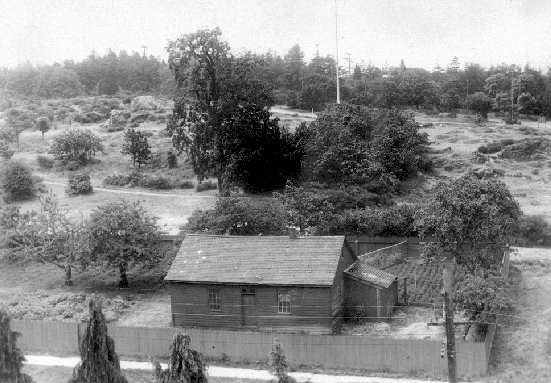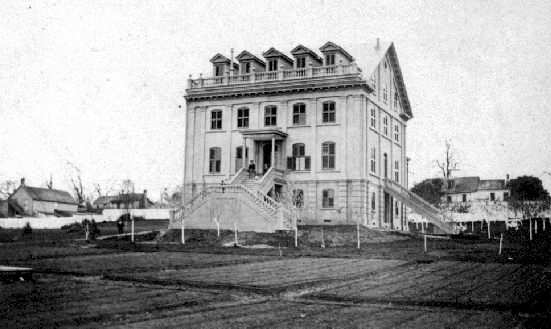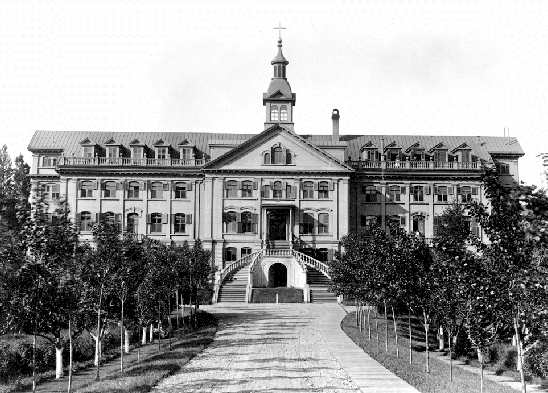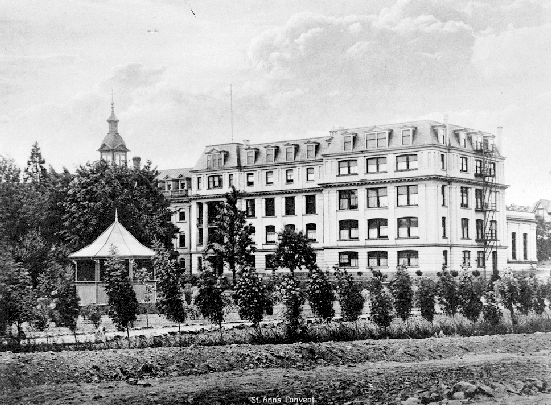St. Ann's: The Buildings
Throughout the nineteenth century religious buildings were constructed for Christian worship, and were used as expressions of Christian belief in a powerful way.1Vicki Bennett, Sacred Space and Structural Style: The Embodiment of Socio-Religious Ideology (Ottawa: University of Ottawa Press, 1997), pg. 11-12. The twentieth century has seen much of this power eroded. Today these buildings tend to be viewed as symbols of an atiquanted institution. As a result we rarely value the architecture of these buildings beyond their superficial qualities. On the other hand, at St. Annís, imbedded in the stone walls and in the stylistic expressions of French architecture, the story of a young province gaining strength is revealed. The story of St. Annís architecture, its architects and the people who helped build the Academy reveal a humble story of pioneers attempting to carve out a familiar place for themselves in a wilderness.
In 1851 Fort Victoria's first Catholic Reverend, Rev. Modeste Demers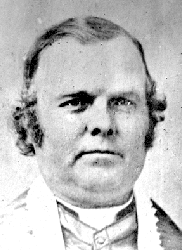
Rev. Modeste Demers ca 1850, commented to friend on the state of religious buildings in the new colony of Vancouver Island:
Why were you there to witness a spectacle which would have been so novel to you! You would have marvelled and perhaps beed edified, at contemplating the Bishop of Vancouver Island kneeling on the truck of an old tree which the waves had roled ashore, and taking possession of that heathen land which the successor of Peter has entrusted him! That ceremony could not take place in my cathedral and you guess why: the lumber which is to serve in its construction is still growing in the forest.2Bishop Demers, in Barry Downs, Sacred Places: British Columbia's Early Churches, (Vancouver: Douglas and McIntyre, 1980), pg. 51.
Even during its humble beginnings as not much more than shack St. Annís was used to accommodate both the secular and sacred needs of early colonial society.3Vicki Bennett, Sacred Space and Structural Style: The Embodiment of Socio-Religious Ideology (Ottawa: University of Ottawa Press, 1997), pg. 258. This refers to the secular use of Eastern Canadian churches St. Annís first school house, purchased by Rev. Modeste Demers
Rev. Modeste Demers ca 1850, was not much more than a small log cabin, the sisters had outgrown this structure by 1871.4Martin Segger and Douglas Franklin, Victoria: A Primer for Regional History in Architecture (Victoria: Heritage Architectural Guides, 1979), pg. 211.
In 1871 Father Joseph Michaud's design for a four storey brick building was carried out by Charles Verrehyden. This new building had strong stylistic connections to the Quebecois origins of the St. Annís order.5Martin Segger and Douglas Franklin, Victoria: A Primer for Regional History in Architecture (Victoria: Heritage Architectural Guides, 1979), pg. 211.
The 1871 original building now serves as the central block to the present structure. The main entrance was a Baroque bi-axial stairway which was replaced in a 1922-24 renovation.6Martin Segger and Douglas Franklin, Victoria: A Primer for Regional History in Architecture (Victoria: Heritage Architectural Guides, 1979), pg. 211. The typically French Canadian steep pitched roof is dotted with dormers, though it is lacking the characteristic bellcast curve.7Leslie Maitland, Jacqueline Hucker, and Shannon Ricketts, A Guide to Canadian Architectural Styles, (Peterborough Ont.: Broadview Press, 1992), pg. 15. It has a fairly plain facade with vertical low relief pilasters.8Martin Segger and Douglas Franklin, Victoria: A Primer for Regional History in Architecture (Victoria: Heritage Architectural Guides, 1979), pg. 211.
In 1886 John Teague produced a much more consciously Baroque building. At the same time as the 1886 addition the old Cathedral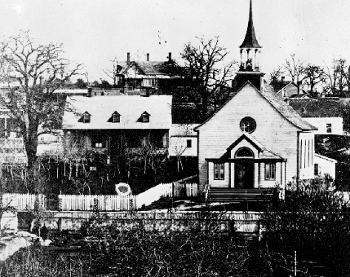
Victoria's First Roman Catholic Cathedral was incorporated into the back of the new structure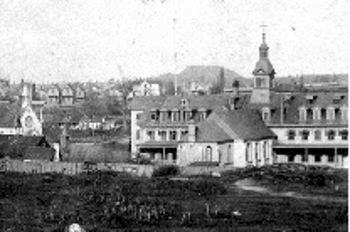
Cathedral in its current position at St. Ann's and the steeple was placed on top.
The 1871 building served as the link between the 1910-1913 Hooper addition and Teague's 1886 addition.
